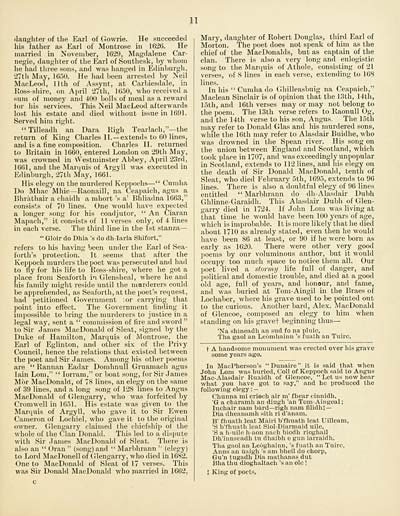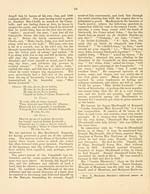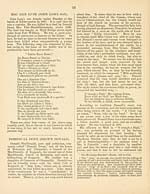Download files
Complete book:
Individual page:
Thumbnail gallery: Grid view | List view

ilaughter of the Earl of Gowrie. He succeeded
his father as Earl of Montrose in 1626. He
married in November, 1629, Magdalene Car-
negie, daughter of the Earl of Southesk, by whom
he had three sons, and was lianged in Edinburgh,
27th May, 1650. He liad been arrested by Neil
MacLeod, 11th of Assynt, at Carbiesdale, in
Koss-shire, on April 27th, 1650, who received a
sum of money and 400 bolls of meal as a reward
for his services. This Neil MacLeod afterwards
lost ills estate and died without issue in 1691.
Served him right.
"Tilleadh an Dara Righ Tearlach,"— the
return of King Charles II. — extends to 60 lines,
and is a fine composition. Charles II. returned
to Britain in 1660, entered London on 29th May,
was crowned in NVestminster Abbey, April 23rd,
1661, and the Marquis of 4rgyll was executed in
Edinburgh, 27th May, 1661.
His elegy on the murdered Keppochs — " Cumha
Do Mhac Mhic — Raonaill, na Ceapaich, agus a
Bhràthair a chaidh a mhort 's a' Bhliadna 1663,"
consists of 70 lines. One would have expected
a longer song for his coadjutor, " An Ciaran
Mapacli," it consists of 11 verses only, of 4 lines
in each verse. The third line in the 1st stanza —
" Glòir do Dhia 's do dh-Iarla Shifort,"
refers to his having been under tlie Earl of Sea-
forth's protection. It seems that after the
Keppoch murders the poet was persecuted and had
to Hy for his life to Koss-shire, Avhere he got a
place from Seaforth in Glensheal, where he and
his family might reside until the murderers could
be apprehended, as Seaforth, at the poet's reqviest,
had petitioned Government lor carrying that
point into efl'ect. The Government finding it
impossible to bring the murderers to justice in a
legal way, sent a " commission of fire and sword"
to Sir James MacDonald of Sleat, signed by the
Duke of Hamilton, Marquis of Montrose, the
Earl of Eglinton, and other six of the Privy
Council, hence the relations that existed between
the poet and Sir James. Anion" his other poems
are " Rannan Eadar DomhnuU Gruamach agus
lain Lorn," " lorram," or boat song, for Sir James
Mòr MacDonald, of 78 lines, an elegy on the same
of 39 lines, and a long song of 128 lines to Angus
MacDonald of Glengarry, who was forfeited by
Cromwell in 1651. His estate was given to the
Marquis of Argyll, who gave it to Sir Ewen
Cameron of Lochiel, who gave it to the original
owner. Glengarry claimed the chiefship of the
whole of the ClanDonald. This led to a dispute
with Sir James MacDonald of Sleat. There is
also an " Gran " (song) and " Marbhrann '' (elegy)
to Lord MacDonell of Glengarry, who died in 1682.
One to MacDonald of Sleat of 17 verses. This
was Sir Donald MacDonald who married in 1662,
Mary, daughter of Robert Douglas, third Earl of
Morton. The poet does not speak of him as the
chief of the MacDonalds, but as captain of the
clan. There is also a very long and eulogistic
song to the Marquis of Athole, consisting of 21
verses, of S lines in each verse, extending to 16S
lines.
In his " Cumha do Ghilleasbuig na Ceapaich,"
Maclean Sinclair is of opinion that the 13th, 14th,
15th, and 16th verses may or may not belong to
tlie poem. The 13th verse refers to Raonull Og,
and the 14th verse to his son, Angus. The 15th
may refer to Donald Glas and his murdered sons,
while the 16th may refer to Alasdair Buidhe, who
was drowned in tlie Spean river. His song on
the union between England and Scotland, which
took place in 1707, and was exceedincdy unpopular
in Scotland, extends to 112 lines, and his elegy on
the death of Sir Donald MacDonald, tenth of
Sleat, who died February 5th, 1695, extends to 96
lines. There is also a doubtful elegy of 96 lines
entitled " Marbhrann do dh- Alasdair Dubh
Ghlinne-Garaidh. This Alasdair Dubh of Glen-
garry died in 1724. If John Lom was living at
tiiat time he would have been 100 years of age,
which is improbable. It is more likely that he died
about 1710 as already stated, even then he would
have been 86 at least, or 90 if he were born as
early as 1620. There were other very good
poems by our voluminous author, but it would
occupy too much space to notice them all. Our
poet lived a stormy life full of danger, and
political and domestic trouble, and died at a good
old age, full of years, and honour, and fame,
and was buried at Tom-Aingil in the Braes of
Lochaber, where his grave used to be pointed out
to the curious. Another bard, Alex. MacDonald
of Glencoe, composed an elegy to him when
standing on his gravet beginning thus—
'Na shineadh an sud fo na pluic,
Tha gaol an Leòmhainn 's fiiath an Tuirc.
t A handsome monument was erected over his grave
some years ago.
In MacPherson's "Dunaire" it is said that when
John Lom was buried, Coll of Keppoch said to Angus
Mac- Alasdair Ruaidh of Glencoe, " Let us now hear
what you have got to say," and he produced the
following elegy : -
Chunna mi crÌGch air m' fhear cinnidh,
'G a charamh an diugh 'an TomAingeal;
luchair nam bard— righ nam filidhj—
Dia dheanamh sith ri d'anam.
B' fhuath leat Màiri b'fhuath leat Uilleam,
'S b'fhuath leat Siol-Diarmaid uile,
'S a h-uile haon nach biodh rioghail
Dh'innseadh tu dhaibh e gun iarraidh.
Tha gaol an Leòghainn, 's fuath an Tuirc,
Anns an ùaigh 's am bheil do chorp,
Gu'n tugadh Dia niathanas dut
Bha thu dioghaltach 's an olc !
} King of poets.
his father as Earl of Montrose in 1626. He
married in November, 1629, Magdalene Car-
negie, daughter of the Earl of Southesk, by whom
he had three sons, and was lianged in Edinburgh,
27th May, 1650. He liad been arrested by Neil
MacLeod, 11th of Assynt, at Carbiesdale, in
Koss-shire, on April 27th, 1650, who received a
sum of money and 400 bolls of meal as a reward
for his services. This Neil MacLeod afterwards
lost ills estate and died without issue in 1691.
Served him right.
"Tilleadh an Dara Righ Tearlach,"— the
return of King Charles II. — extends to 60 lines,
and is a fine composition. Charles II. returned
to Britain in 1660, entered London on 29th May,
was crowned in NVestminster Abbey, April 23rd,
1661, and the Marquis of 4rgyll was executed in
Edinburgh, 27th May, 1661.
His elegy on the murdered Keppochs — " Cumha
Do Mhac Mhic — Raonaill, na Ceapaich, agus a
Bhràthair a chaidh a mhort 's a' Bhliadna 1663,"
consists of 70 lines. One would have expected
a longer song for his coadjutor, " An Ciaran
Mapacli," it consists of 11 verses only, of 4 lines
in each verse. The third line in the 1st stanza —
" Glòir do Dhia 's do dh-Iarla Shifort,"
refers to his having been under tlie Earl of Sea-
forth's protection. It seems that after the
Keppoch murders the poet was persecuted and had
to Hy for his life to Koss-shire, Avhere he got a
place from Seaforth in Glensheal, where he and
his family might reside until the murderers could
be apprehended, as Seaforth, at the poet's reqviest,
had petitioned Government lor carrying that
point into efl'ect. The Government finding it
impossible to bring the murderers to justice in a
legal way, sent a " commission of fire and sword"
to Sir James MacDonald of Sleat, signed by the
Duke of Hamilton, Marquis of Montrose, the
Earl of Eglinton, and other six of the Privy
Council, hence the relations that existed between
the poet and Sir James. Anion" his other poems
are " Rannan Eadar DomhnuU Gruamach agus
lain Lorn," " lorram," or boat song, for Sir James
Mòr MacDonald, of 78 lines, an elegy on the same
of 39 lines, and a long song of 128 lines to Angus
MacDonald of Glengarry, who was forfeited by
Cromwell in 1651. His estate was given to the
Marquis of Argyll, who gave it to Sir Ewen
Cameron of Lochiel, who gave it to the original
owner. Glengarry claimed the chiefship of the
whole of the ClanDonald. This led to a dispute
with Sir James MacDonald of Sleat. There is
also an " Gran " (song) and " Marbhrann '' (elegy)
to Lord MacDonell of Glengarry, who died in 1682.
One to MacDonald of Sleat of 17 verses. This
was Sir Donald MacDonald who married in 1662,
Mary, daughter of Robert Douglas, third Earl of
Morton. The poet does not speak of him as the
chief of the MacDonalds, but as captain of the
clan. There is also a very long and eulogistic
song to the Marquis of Athole, consisting of 21
verses, of S lines in each verse, extending to 16S
lines.
In his " Cumha do Ghilleasbuig na Ceapaich,"
Maclean Sinclair is of opinion that the 13th, 14th,
15th, and 16th verses may or may not belong to
tlie poem. The 13th verse refers to Raonull Og,
and the 14th verse to his son, Angus. The 15th
may refer to Donald Glas and his murdered sons,
while the 16th may refer to Alasdair Buidhe, who
was drowned in tlie Spean river. His song on
the union between England and Scotland, which
took place in 1707, and was exceedincdy unpopular
in Scotland, extends to 112 lines, and his elegy on
the death of Sir Donald MacDonald, tenth of
Sleat, who died February 5th, 1695, extends to 96
lines. There is also a doubtful elegy of 96 lines
entitled " Marbhrann do dh- Alasdair Dubh
Ghlinne-Garaidh. This Alasdair Dubh of Glen-
garry died in 1724. If John Lom was living at
tiiat time he would have been 100 years of age,
which is improbable. It is more likely that he died
about 1710 as already stated, even then he would
have been 86 at least, or 90 if he were born as
early as 1620. There were other very good
poems by our voluminous author, but it would
occupy too much space to notice them all. Our
poet lived a stormy life full of danger, and
political and domestic trouble, and died at a good
old age, full of years, and honour, and fame,
and was buried at Tom-Aingil in the Braes of
Lochaber, where his grave used to be pointed out
to the curious. Another bard, Alex. MacDonald
of Glencoe, composed an elegy to him when
standing on his gravet beginning thus—
'Na shineadh an sud fo na pluic,
Tha gaol an Leòmhainn 's fiiath an Tuirc.
t A handsome monument was erected over his grave
some years ago.
In MacPherson's "Dunaire" it is said that when
John Lom was buried, Coll of Keppoch said to Angus
Mac- Alasdair Ruaidh of Glencoe, " Let us now hear
what you have got to say," and he produced the
following elegy : -
Chunna mi crÌGch air m' fhear cinnidh,
'G a charamh an diugh 'an TomAingeal;
luchair nam bard— righ nam filidhj—
Dia dheanamh sith ri d'anam.
B' fhuath leat Màiri b'fhuath leat Uilleam,
'S b'fhuath leat Siol-Diarmaid uile,
'S a h-uile haon nach biodh rioghail
Dh'innseadh tu dhaibh e gun iarraidh.
Tha gaol an Leòghainn, 's fuath an Tuirc,
Anns an ùaigh 's am bheil do chorp,
Gu'n tugadh Dia niathanas dut
Bha thu dioghaltach 's an olc !
} King of poets.
Set display mode to: Large image | Transcription
Images and transcriptions on this page, including medium image downloads, may be used under the Creative Commons Attribution 4.0 International Licence unless otherwise stated. ![]()
| Early Gaelic Book Collections > Ossian Collection > Macdonald bards from mediaeval times > (21) |
|---|
| Permanent URL | https://digital.nls.uk/80460653 |
|---|
| Description | Selected books from the Ossian Collection of 327 volumes, originally assembled by J. Norman Methven of Perth. Different editions and translations of James MacPherson's epic poem 'Ossian', some with a map of the 'Kingdom of Connor'. Also secondary material relating to Ossianic poetry and the Ossian controversy. |
|---|
| Description | Selected items from five 'Special and Named Printed Collections'. Includes books in Gaelic and other Celtic languages, works about the Gaels, their languages, literature, culture and history. |
|---|

